
It isn't always possible to spend birthdays with each of the family but knowing that Suzi always takes time off work to spoil herself for her birthday, I decided to ask her if I could join her. There was a little hesitation as she mulled over what she had planned and whether I would be able to 'keep up' with her. But when I assured her that if she wanted to do strenuous walks, I would be more than happy to sit somewhere beautiful and enjoy the environment or read my book, she decided that it would work. So I planned a 10-day visit to Tauranga and arrived on Monday 6 December. She was working that day so she dropped me at her lovely little home and I settled in.
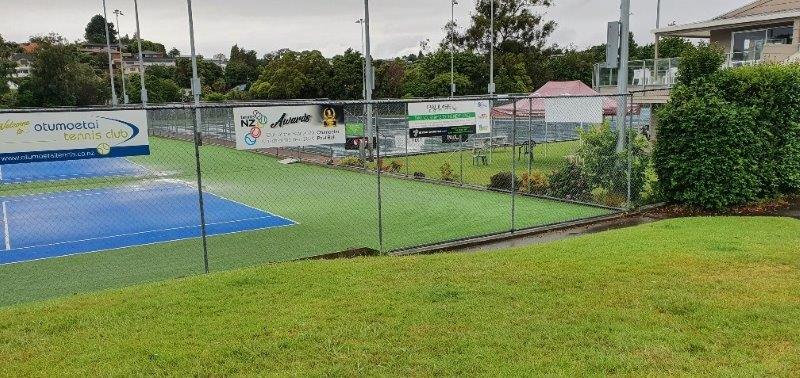 We weren't leaving on our adventure until Wednesday afternoon but her holiday started on Tuesday and we set off together for her Tennis Club, Otumoetai Tennis Club, where she joins in on Club days when she doesn't have a morning shift. What an
We weren't leaving on our adventure until Wednesday afternoon but her holiday started on Tuesday and we set off together for her Tennis Club, Otumoetai Tennis Club, where she joins in on Club days when she doesn't have a morning shift. What an 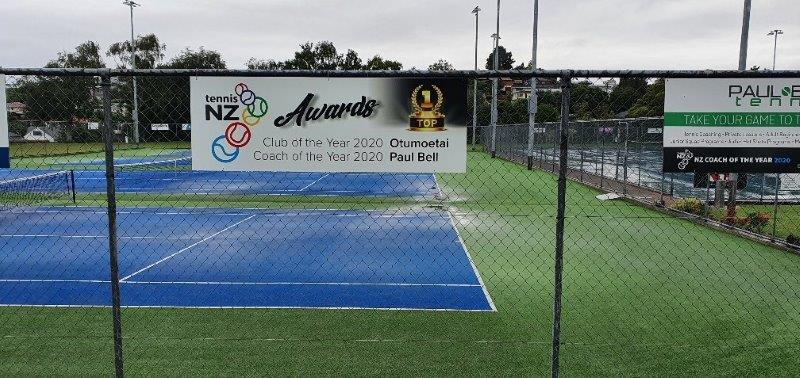 amazing club it is. I've played at many clubs in England and New Zealand but this was the best I've seen. There are 12 all-purpose courts spread around the Club House which has an enormous balcony on two sides so that spectators can see any of the courts at all times. And when I inspected the signage on the side of the court nearest the entrance, The sign on the side of the court read that Otumoetai was Club of the Year for 2021 and its coach, Paul Bell, Coach of the Year. What more could Suzi ask?
amazing club it is. I've played at many clubs in England and New Zealand but this was the best I've seen. There are 12 all-purpose courts spread around the Club House which has an enormous balcony on two sides so that spectators can see any of the courts at all times. And when I inspected the signage on the side of the court nearest the entrance, The sign on the side of the court read that Otumoetai was Club of the Year for 2021 and its coach, Paul Bell, Coach of the Year. What more could Suzi ask?
Crowds of people were arriving and the courts were soon full. The welcome was really lovely. Two members greeted everyone, took names and inspected Vaccine Passports. I was shown to the balcony and directed to the coffee and tea facilities so that I could overlook Suzi's games whichever court she played on. It was a lovely way to spend my first full day in Tauranga.
The rest of the day was spent grocery shopping, stopping for coffee at one of our favourite haunts, a bit of window shopping, and spending a bit of time in the garden.
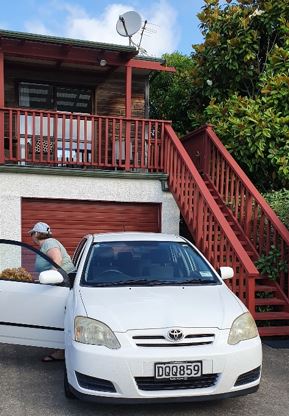 The next day was Day 1 of our holiday. We set off for our first night in Ohope, a beautiful coastal village, that Suzi has visited before and really likes. We arrived at a lovely Airbnb owned by the parents of Lisa Carrington, now a Dame, an Olympian gold medal-winning flat-water canoeist.
The next day was Day 1 of our holiday. We set off for our first night in Ohope, a beautiful coastal village, that Suzi has visited before and really likes. We arrived at a lovely Airbnb owned by the parents of Lisa Carrington, now a Dame, an Olympian gold medal-winning flat-water canoeist.
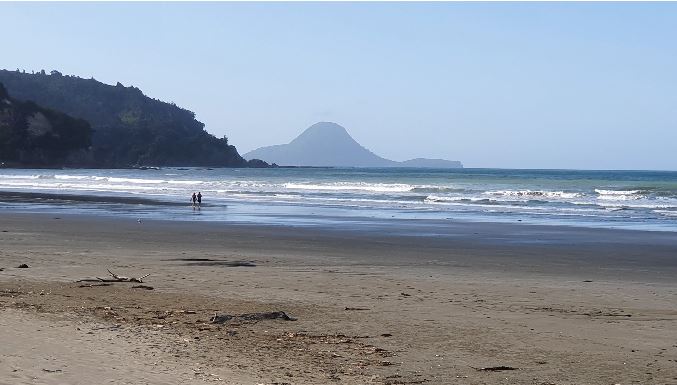 It wasn't long before the beach called us to go for an early evening walk and we
It wasn't long before the beach called us to go for an early evening walk and we 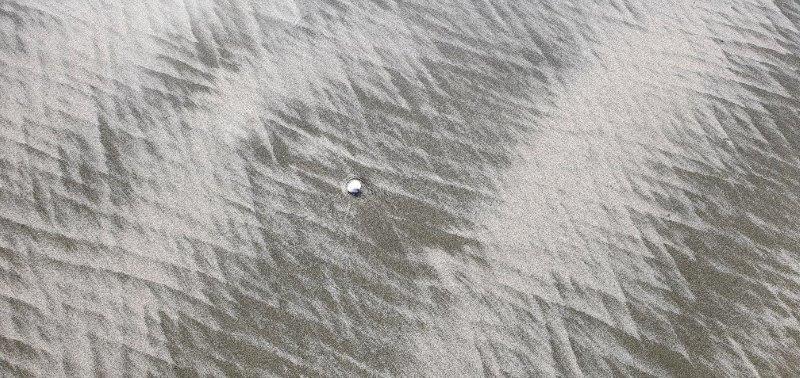 marvelled at the wondrous patterns that the tide was making on the sand.
marvelled at the wondrous patterns that the tide was making on the sand.
Deciding we'd like to see what we could find for dinner, we drove to the end of Port Ohope Wharf.  This was something of a misnomer in that there is no longer a port to be found. There was, however, a restaurant called Ohope Fisherman's Wharf Cafe and there we enjoyed a delicious meal on the balcony while the sun set over the water. We felt truly blessed.
This was something of a misnomer in that there is no longer a port to be found. There was, however, a restaurant called Ohope Fisherman's Wharf Cafe and there we enjoyed a delicious meal on the balcony while the sun set over the water. We felt truly blessed.
Day 2 was to be our biggest day as we wanted to cover a lot of ground because we’d been unable to find a suitable Airbnb between Ohope and Gisborne.
 Hugging the coast after we had passed through Whakatane, we passed this beautiful little church on the side of the road. The Anglican church of Raukokore is on the Pacific Coast Highway at Waihau Bay near Opotiki and stands on the very edge of the ocean. Unfortunately, it was locked so we couldn’t go inside but it is a magnificent sight, seemingly in the middle of nowhere.
Hugging the coast after we had passed through Whakatane, we passed this beautiful little church on the side of the road. The Anglican church of Raukokore is on the Pacific Coast Highway at Waihau Bay near Opotiki and stands on the very edge of the ocean. Unfortunately, it was locked so we couldn’t go inside but it is a magnificent sight, seemingly in the middle of nowhere.
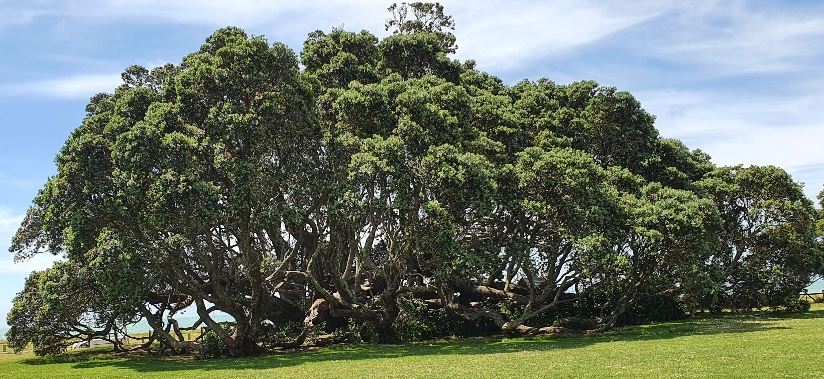 One sight on the way there that was certainly worth a visit was the giant Pohutakawa tree at Te Waha o Rerekohu the mouth of Rerekohu. It is thought to be the largest pōhutukawa tree in New Zealand. At least 600 years old, it had a branch span of more than 37 metres when it was measured in 1950.
One sight on the way there that was certainly worth a visit was the giant Pohutakawa tree at Te Waha o Rerekohu the mouth of Rerekohu. It is thought to be the largest pōhutukawa tree in New Zealand. At least 600 years old, it had a branch span of more than 37 metres when it was measured in 1950.
 The most important destination for the day, so far as Suzi was concerned, was to walk to East Cape Lighthouse. Unfortunately, however, such was the negative publicity surrounding Covid that many of the sights that we had wanted to explore were closed to visitors and we could only enjoy the view from afar. We did actually venture along the metal road to the right of the photo but a closed gate was all we got for our trouble. We were both very disappointed.
The most important destination for the day, so far as Suzi was concerned, was to walk to East Cape Lighthouse. Unfortunately, however, such was the negative publicity surrounding Covid that many of the sights that we had wanted to explore were closed to visitors and we could only enjoy the view from afar. We did actually venture along the metal road to the right of the photo but a closed gate was all we got for our trouble. We were both very disappointed.
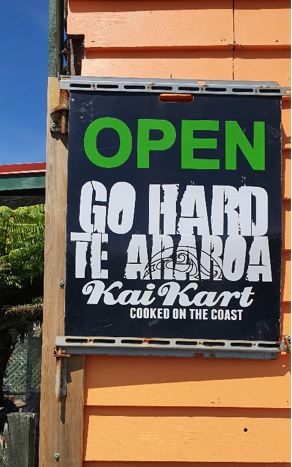 However, one saving grace was at the dairy nearby where the welcome was really lovely. The owner apologised that we couldn’t walk to the Lighthouse which wasn’t, of course, her fault.
However, one saving grace was at the dairy nearby where the welcome was really lovely. The owner apologised that we couldn’t walk to the Lighthouse which wasn’t, of course, her fault.
 Everywhere we travelled, we passed logging trucks and whether we passed them or came up behind them on the road, we found the drivers unfailingly polite and helpful. They obviously knew the roads intimately so all we had to do was to stay back so that they could see us out of their wing mirrors, and wait for the inevitable indication that we could pass safely. Whatever we’ve heard in the
Everywhere we travelled, we passed logging trucks and whether we passed them or came up behind them on the road, we found the drivers unfailingly polite and helpful. They obviously knew the roads intimately so all we had to do was to stay back so that they could see us out of their wing mirrors, and wait for the inevitable indication that we could pass safely. Whatever we’ve heard in the 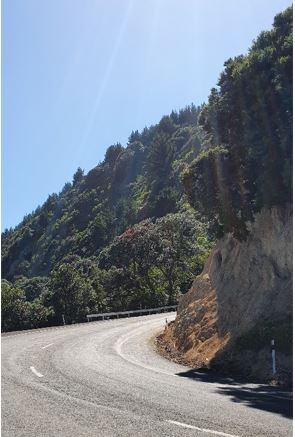 past about truckies being poor drivers, we can testify to the fact that those on the East Coast were, without exception, excellent. It’s true to say that sometimes we had to wait a while before we could pass because there were bends to negotiate almost everywhere. But the trucks travelled at a decent speed and the views over the ocean on one side and the towering cliffs festooned in native bush on the other provided such vistas that there seemed no need to rush.
past about truckies being poor drivers, we can testify to the fact that those on the East Coast were, without exception, excellent. It’s true to say that sometimes we had to wait a while before we could pass because there were bends to negotiate almost everywhere. But the trucks travelled at a decent speed and the views over the ocean on one side and the towering cliffs festooned in native bush on the other provided such vistas that there seemed no need to rush.
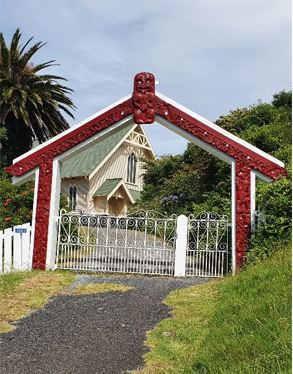 Suzi had earmarked several places for us to visit and we were very keen to explore the non-denominational church of St Mary’s in Tikitiki, near Tairawhiti, north of Gisborne. Said to be one of the most beautiful Māori churches in New Zealand, St Mary’s church is of great spiritual and historical significance to Ngāti Porou and is classified as a Category 1 Historic Place by Heritage New Zealand. It was built between 1924 and 1926 under the guidance of Sir Āpirana Ngata to remember the Ngāti Porou soldiers who fought and died in World War I, and serves as a memorial to the Maori men from the East Coast between Paritu (south of Gisborne) and Tarakeha/Torere.
Suzi had earmarked several places for us to visit and we were very keen to explore the non-denominational church of St Mary’s in Tikitiki, near Tairawhiti, north of Gisborne. Said to be one of the most beautiful Māori churches in New Zealand, St Mary’s church is of great spiritual and historical significance to Ngāti Porou and is classified as a Category 1 Historic Place by Heritage New Zealand. It was built between 1924 and 1926 under the guidance of Sir Āpirana Ngata to remember the Ngāti Porou soldiers who fought and died in World War I, and serves as a memorial to the Maori men from the East Coast between Paritu (south of Gisborne) and Tarakeha/Torere.
The towns surrounding Tikitiki historically had a racecourse, four rugby teams, and several shops fuelled by a thriving dairy industry. In the 1950s and 1960s, the towns had a combined population of 6,000, but an economic downturn in the area in the mid to late 1960s led to urban drift, and 2011 figures put the population of both towns at 528. 95% of the towns' inhabitants identify as Māori. Most people in these towns are either homemakers, or employed in the roading, forestry, farming, or food industries, or as office workers.
Once again we were very disappointed to find that the church was locked so we were unable to see the interior which is purported to contain many beautiful carvings.
 Travelling further south, we arrived at Tokomaru Bay. It was a beautiful day and we decided to walk to the end of the Wharf which is open to the public. Tokomaru Bay Wharf has historical and social significance as a recognisable remnant of a once-thriving industry in Waima. It is part of an interwoven group of structures that stand testament to the freezing works and shipping industries that once provided jobs for
Travelling further south, we arrived at Tokomaru Bay. It was a beautiful day and we decided to walk to the end of the Wharf which is open to the public. Tokomaru Bay Wharf has historical and social significance as a recognisable remnant of a once-thriving industry in Waima. It is part of an interwoven group of structures that stand testament to the freezing works and shipping industries that once provided jobs for  hundreds of people in the Tokomaru Bay area. With rocky headlands at each end of the bay and a golden beach, it sprawls along 8kms of coastline. Extensive wharf improvements and rock removal allowed vessels drawing almost 12 feet to berth. The Wharf’s busiest years were those between 1913 and 1916 when 400 vessels were handled annually.
hundreds of people in the Tokomaru Bay area. With rocky headlands at each end of the bay and a golden beach, it sprawls along 8kms of coastline. Extensive wharf improvements and rock removal allowed vessels drawing almost 12 feet to berth. The Wharf’s busiest years were those between 1913 and 1916 when 400 vessels were handled annually.
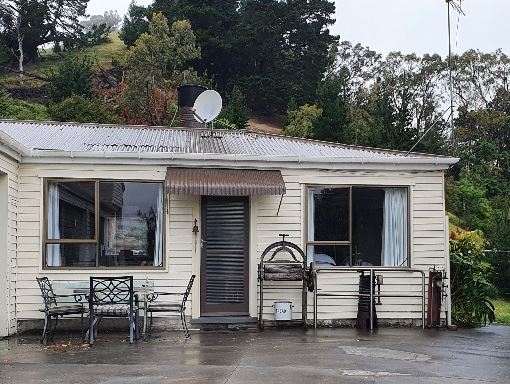 By the time we finally arrived at our Airbnb destination, it was quite late. As it turned out, the Airbnb we did find on the outskirts of Gisborne was full of knick-knacks. It was excellent for our needs and we stayed there for three nights. Our hosts gave us a lovely warm welcome and we settled in quickly, keen to go out and get some dinner as we hadn’t had much time to stop for snacks on the journey.
By the time we finally arrived at our Airbnb destination, it was quite late. As it turned out, the Airbnb we did find on the outskirts of Gisborne was full of knick-knacks. It was excellent for our needs and we stayed there for three nights. Our hosts gave us a lovely warm welcome and we settled in quickly, keen to go out and get some dinner as we hadn’t had much time to stop for snacks on the journey.
Here we ran into another adventure! Our hosts suggested quite a few alternative eating places and off we went. After finding the first two closed – at 8.30 pm – we decided to ring others before traipsing around Gisborne while the clock ticked away. Absolutely everything was closed and we discovered that the industries in Gisborne cause the inhabitants to rise very early in the mornings for breakfast around 5.00 am and as a consequence, all the eating places close very early too.
Fairly desperate, we ended up at a BP garage where the kind staff member, who was just closing up and had cleared away all the food, took pity on us and heated up a couple of bacon and egg pies. Armed with a bag of crisps and a bottle of wine we thought ourselves pretty lucky in the circumstances.
I’m not quite sure why we did, but the next day we decided to drive down to Mahia peninsula. I think it was because some of the children’s friends when they were little had holidayed there and waxed poetic about what great holidays they’d had.
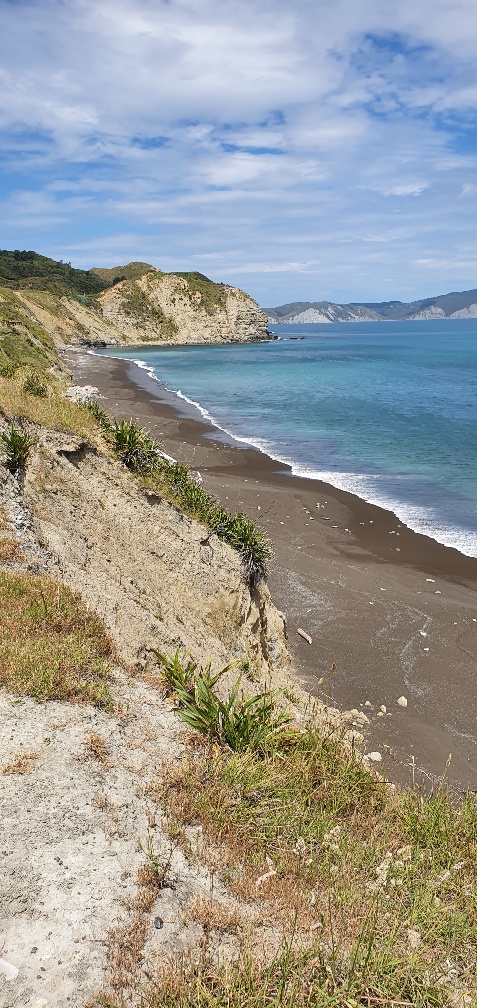 In the event, it was a fairly long journey with lots of beautiful things to see on the way, but not much to explore when we finally got there. The coastland as we approached the peninsula was really lovely. The sands were quite brown but we didn’t actually venture off the road and down onto the beach below.
In the event, it was a fairly long journey with lots of beautiful things to see on the way, but not much to explore when we finally got there. The coastland as we approached the peninsula was really lovely. The sands were quite brown but we didn’t actually venture off the road and down onto the beach below.
As there weren’t many signposts, we ventured onto a sealed road that seemed to lead into the hills. We drove uphill for miles and finally came to a closed gate which was disappointing as we kept thinking that there would be a 360-degree view just around the next bend.
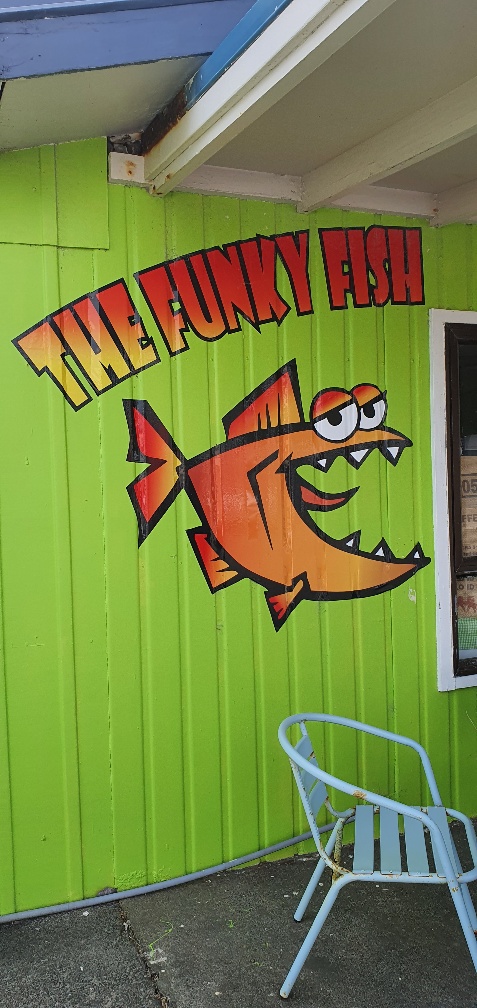 We did, however, find a lovely little Dairy cum café when we got back to ground level again and enjoyed the friendly hospitality of the owner and some homemade goodies.
We did, however, find a lovely little Dairy cum café when we got back to ground level again and enjoyed the friendly hospitality of the owner and some homemade goodies.
We’d decided not to risk a second weird dinner and had booked ahead at Crawford Road 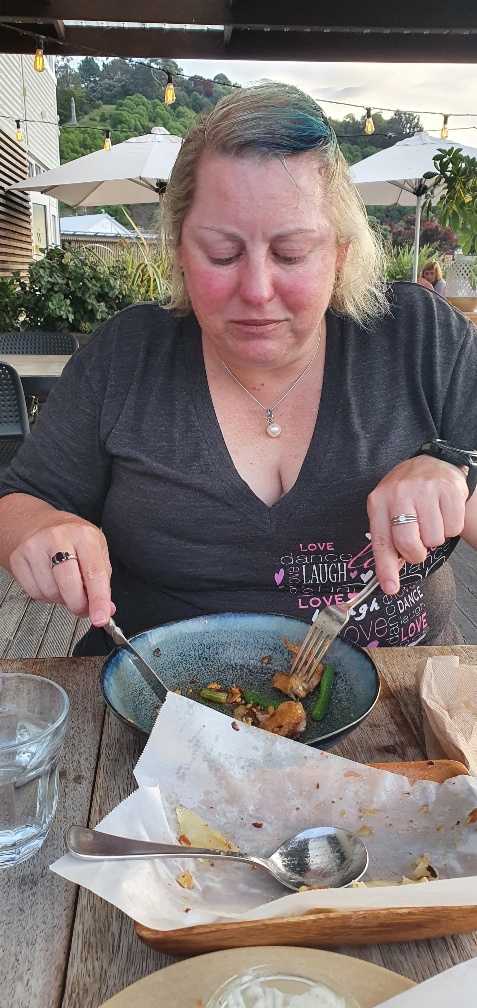 kitchens in the centre of Gisborne where we could enjoy the sunset over the ocean. The menu was very different and we had to ask for explanations for some of the items, but one thing that was very delicious was a huge bowl of mung beans to share for starters. And Suzi soon polished off her main as well.
kitchens in the centre of Gisborne where we could enjoy the sunset over the ocean. The menu was very different and we had to ask for explanations for some of the items, but one thing that was very delicious was a huge bowl of mung beans to share for starters. And Suzi soon polished off her main as well.
The next day was our last full day in Gisborne before we started on the journey home. We checked out the Captain Cook monument on Kaiti Beach Road. The Cook Landing Site National Historic Reserve marks the place where James  Cook first set foot on New Zealand soil. It was here on the 9th and 10th of October, 1769 Cook walked with men from HM Bark Endeavour seeking fresh food and water. Nearby on the river rock Toka-a-Taiau, the Maori chief and English greeted one another. When traditional challenges were misunderstood Maori were killed, the ship sailed without provisions, and thus Poverty Bay received its name.
Cook first set foot on New Zealand soil. It was here on the 9th and 10th of October, 1769 Cook walked with men from HM Bark Endeavour seeking fresh food and water. Nearby on the river rock Toka-a-Taiau, the Maori chief and English greeted one another. When traditional challenges were misunderstood Maori were killed, the ship sailed without provisions, and thus Poverty Bay received its name.
 Another statue nearby is that of Nicholas Young, the surgeon's boy, who was purportedly the first to see land. The Poverty Bay headland Te Kurī a Pāoa was named Young Nick's Head by Cook in memory of the event, although this is unlikely to have been the first piece of land sighted.
Another statue nearby is that of Nicholas Young, the surgeon's boy, who was purportedly the first to see land. The Poverty Bay headland Te Kurī a Pāoa was named Young Nick's Head by Cook in memory of the event, although this is unlikely to have been the first piece of land sighted.
Incidentally, I read that the site of Cook's first New Zealand landfall is also believed to be the landing place of the Horouta and Te Ikaroa-a-Rauru waka (canoes), which carried Māori settlers to the district around 1350AD.
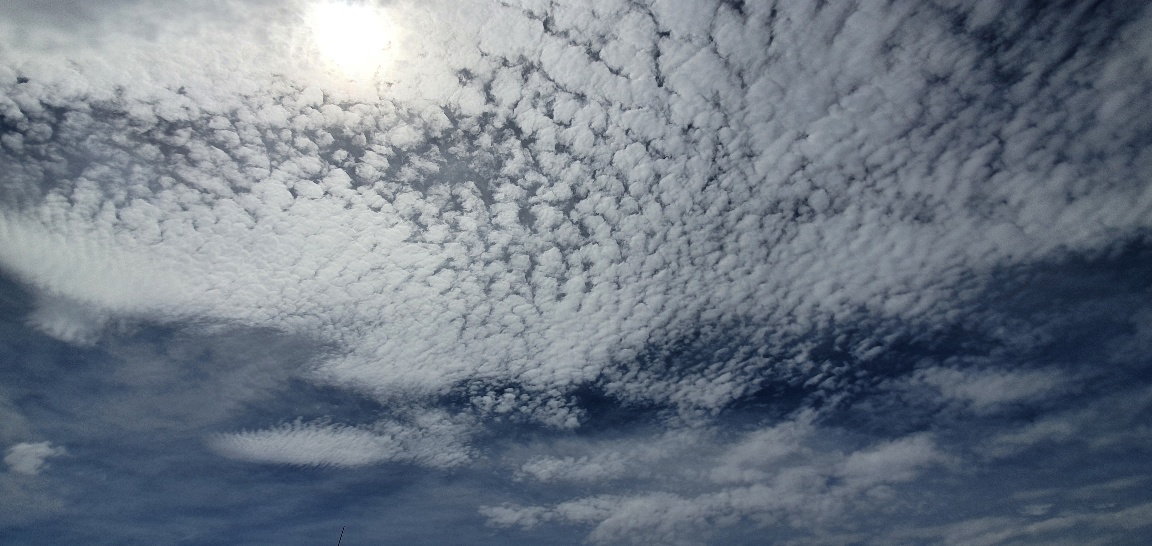 Nearby, there was a farmer’s food market which was fun to stroll around in the lovely warm weather. Leaving that, we drove to Kaiti Hill under the most magnificent cloud formation.
Nearby, there was a farmer’s food market which was fun to stroll around in the lovely warm weather. Leaving that, we drove to Kaiti Hill under the most magnificent cloud formation.
 Kaiti Hill stands high above Gisborne. It’s a sprawling 35ha reserve with amazing views of the city centre and its three rivers. At its summit are a wealth of information signs describing the history of the area.
Kaiti Hill stands high above Gisborne. It’s a sprawling 35ha reserve with amazing views of the city centre and its three rivers. At its summit are a wealth of information signs describing the history of the area.
 And so it was time to get ready for our journey the next morning. We woke to appalling rain and low cloud which was such a shame, considering the terrain we would be driving on through the Waioeka Gorge. Before we left Gisborne, however, I had to take a photo through the car window of the magnificent Jacaranda trees that were flowing on nearly every street. A gorgeous site. I wish I could grow one in my garden.
And so it was time to get ready for our journey the next morning. We woke to appalling rain and low cloud which was such a shame, considering the terrain we would be driving on through the Waioeka Gorge. Before we left Gisborne, however, I had to take a photo through the car window of the magnificent Jacaranda trees that were flowing on nearly every street. A gorgeous site. I wish I could grow one in my garden.
 The Waioeka Gorge is a scenic reserve with spectacular bush and river views. Unfortunately, the rain was so heavy that we couldn’t venture out of the car so all our photos were taken from inside through quite a lot of low mist. Situated on State Highway 2 south of Opotiki at the northern end, Waioeka Gorge Scenic Reserve is an 1800-hectare area of native forest and regenerating farmland. Some of the reserve was cleared for farming after World War 1, but the settlers couldn’t produce enough from the land to make their efforts worthwhile. They left behind them the Tauranga and Manganuku Bridges - the Tauranga Bridge is one of only two harp suspension bridges in the country.
The Waioeka Gorge is a scenic reserve with spectacular bush and river views. Unfortunately, the rain was so heavy that we couldn’t venture out of the car so all our photos were taken from inside through quite a lot of low mist. Situated on State Highway 2 south of Opotiki at the northern end, Waioeka Gorge Scenic Reserve is an 1800-hectare area of native forest and regenerating farmland. Some of the reserve was cleared for farming after World War 1, but the settlers couldn’t produce enough from the land to make their efforts worthwhile. They left behind them the Tauranga and Manganuku Bridges - the Tauranga Bridge is one of only two harp suspension bridges in the country.
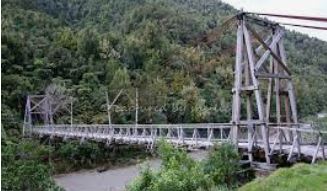 A suspension bridge, for the uninitiated, is a type of bridge in which the deck is hung below suspension cables on vertical suspenders where a bridge cannot be built normally on pillars. Another famous example is the Clifton Suspension Bridge spanning the Avon Gorge and the River Avon, linking Clifton in Bristol to Leigh Woods in North Somerset.
A suspension bridge, for the uninitiated, is a type of bridge in which the deck is hung below suspension cables on vertical suspenders where a bridge cannot be built normally on pillars. Another famous example is the Clifton Suspension Bridge spanning the Avon Gorge and the River Avon, linking Clifton in Bristol to Leigh Woods in North Somerset.
And so we reached Tauranga again, better informed about history in New Zealand but still sad that we hadn’t been able to visit some of its wonderful treasures.
